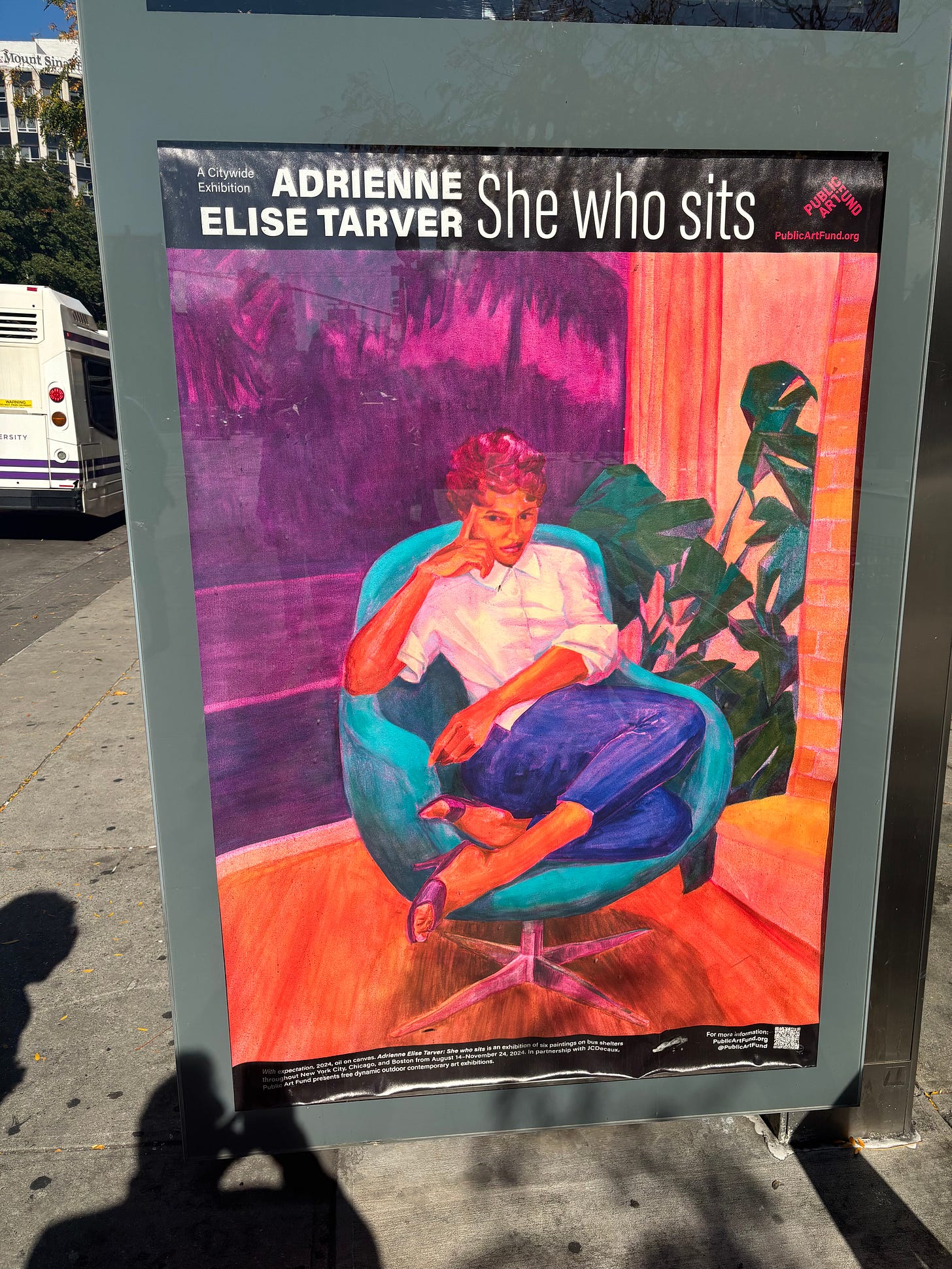New York's Bus Stop Gallery
The Public Art Fund makes a star.
New York City has a lot of great art in public. There’s The Alamo sculpture near Astor Place, a Carole Feuerman sculpture on Park Avenue in midtown, murals by Hektad all around the Lower East Side and FiDi and gardens of anthropomorphic wildlife by environmentalist sculptors Gillie and Marc. But what’s really caught my eye over the last few months is a collection of posters at bus stops, all prints from the work of portraitist Adrienne Elise Tarver. The citywide exhibition is called “She Who Sits.”
Well, let me show you:
Tarver’s work, which I seem to encounter every few days, is full of what I love — impressionist brushwork in the backgrounds and faces that make you feel like you’ve encountered a living soul. Tarver has a story about black women in history and society, but it’s hers to tell and mine to continue learning about. Each of these women en situ stand alone for me, all are worth a long gaze and thought and they always lift my spirits.
On Wednesday night, The Scholar Wife invited me to a talk at The Cooper Union, which I had coincidentally been writing about here, with reference to Joseph Campbell’s series of lectures in the 1960s and 70s. As I’d been working out of town that day, I had no idea what the talk was going to be about. It turned out to be a dialogue between Tarver and Jenée-Daria Strand, a curator at The Public Art Fund who helped Tarver assemble the show in collaboration with ARTNOIR, a woman and minority-owned art collective and major cultural force in New York.
So, not only is the Cooper Union continuing to fulfill its mission of providing free public educational and cultural events, but I actually got to meet and compliment the painter whose work I’ve been admiring. That may sound like a minor thing but being able to appreciate living artists in person is a huge privilege.
The whole event and its serendipity is a great reminder that our culture remains vital and that creative people are working to make all our days a little bit better, and giving us things to think about as they do. It’s easy to fall into cultural doomsaying, but there are many reasons for optimism. A little kismet never hurts, either.
Yesterday, The Scholar Wife brought me to two other art events featuring talented, living artists. At the Isabel Sullivan Gallery we saw a collection of dazzling landscapes, portraits and slices of life by Antonio Caicedo Holguin, Joanna Galego and Stephanie Montieth.
Later, we met the creators of The Trellis Art Fund, which made its first grants to a dozen young artists, to be used at the discretion of each creator, without restriction. It’s a bold move in a philanthropic environment where timid donors avoid controversy by donating to institutions rather than individual artists. It also answers a vital need in the art world as living artists always have a hard time getting paid enough for their work to fund more work. Corina Larkin, Trellis’ executive director told me that her parents were artists and she had taken another path into consulting and finance and has since evolved into a career in creative philanthropy. She believes the civil society has an important role to play helping early career artists to establish themselves because art markets are inefficient, lack transparency, and even alignment between the interests of creators and dealers.
Nurturing art as a mission for civil society has been under fire for decades now as more technocratic minds have pushed to more precisely quantify the effects of philanthropy. Measuring checklist items like vaccines or meals distributed makes a lot of sense, but those who support cultural philanthropy can’t as easily measure the impacts of careers launched or souls enriched.
I suspect, and very much hope, that The Public Art Fund and ARTNOIR have launched Tarver from bus stops to major gallery shows and that her work will reach beyond sales private collections and into museums. I’ll also be watching the inaugural grantees from Trellis. Artists and civic institutions are doing some incredible work right now, when we need it most.


